From piano keyboards to smartphones, a wide range of instruments can interface with MIDI to unleash musical creativity.
MIDI (Musical Instrument Digital Interface) allows instruments and controllers to connect with computers, tablets, synths and drum machines for infinite sound manipulation possibilities during music production and performance.
Let’s explore the diverse array of tools that can function as MIDI controllers.
Which Instruments Can Be Used as MIDI Controllers?

A huge variety of instruments ranging from electronic drum pads to violin pickups to circuit bent toys can interface as MIDI controllers.
We’ll explore the specifics more below, but in short – if it can generate or manipulate an electronic signal, chances are high it can become a MIDI controller.
Keyboards
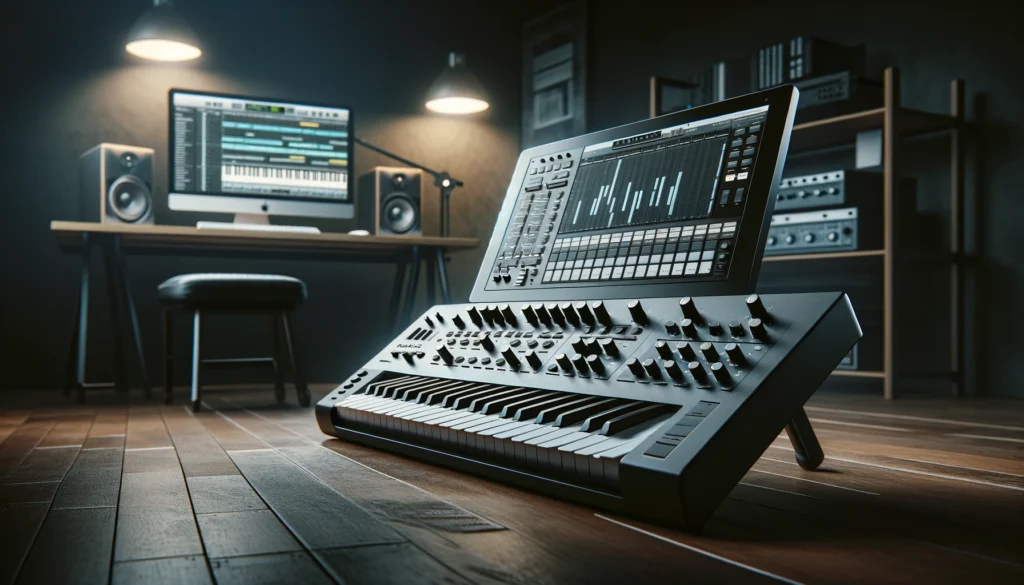
Digital pianos and keyboards with MIDI capabilities such as USB connections or five-pin MIDI ports can easily be used as MIDI controllers.
Regular computer keyboards can also be mapped to function as MIDI controllers through software such as Logic Pro and Ableton Live, allowing you to trigger software instruments and control parameters from your QWERTY keys.
There are also dedicated MIDI keyboard controllers designed specifically for music production, featuring assignable knobs, sliders, pads, transport controls and other tools for controlling software devices and DAW functions.
Digital Pianos and Keyboards
Many digital pianos and high-end synthesizers nowadays have MIDI ports and connectivity built in.
Common offerings include five-pin MIDI input and output ports or more modern USB MIDI ports.
This allows the instrument’s keyboard, knobs and controllers to be utilized for playing virtual instruments in a DAW or controlling hardware MIDI devices.
The instrument effectively becomes a MIDI controller itself, where each key is independent and can be mapped or recorded into any software.
Computer Keyboards
Through MIDI mapping software capabilities in most major DAWs, even a basic computer keyboard can be customized to function as a MIDI controller.
Individual keys can have notes assigned to them to perform software instruments using the computer’s regular QWERTY keyboard.
Parameters like track volumes, pan controls and effect plug-in settings can also be mapped to keys.
While limited, this allows anyone with a standard keyboard and MIDI-capable software to get started with MIDI composition and performance with no extra tools required.
MIDI Keyboard Controllers
For musicians and producers who want a better performance typing and more controller options, dedicated MIDI keyboard controllers provide a full music production toolset.
Units like the Native Instruments Komplete Kontrol S-Series or Akai Professional MPK mini play synth offer full-size instrument control boards designed specifically for use as MIDI input devices.
They offer features like semi-weighted keys for piano-like playing, pitch and modulation wheels, assignable sliders, knobs and touch strips, transport controls, arpeggiators and note repeat triggers.
Advanced models feature large color screens and deeply tight DAW and software integration.
Electronic Musical Instruments

Thanks to the electronic nature of their sound generation and modern connectivity standards, many electronic musical instruments have MIDI capabilities built in for interfacing with computers.
Electronic drums, MIDI pickup equipped string instruments and high-tech MIDI wind instruments allow performers to record MIDI patterns directly from playing their instrument of expertise.
This expands the creative possibilities and sound design flexibility beyond an instrument’s own natural timbre.
Electronic Drum Kits and Pads
Most modern electronic drum kits with sounds like the popular Roland V-Drums, the Yamaha DTX or Alesis Nitro now come standard with MIDI output connections.
This allows real drum playing expression and dynamics to drive MIDI percussion instruments within sequencer software or act as a MIDI click track generator for the rest of the band to play in sync with.
Individual drum trigger pads which drum sticks are hit against, like those from the company Alesis or Behringer also have MIDI out over USB or five-pin for custom drum trigger setups.
MIDI Pickup Equipped Instruments
Through clever electronic engineering, MIDI pickup devices are also available which convert the vibrations and string oscillations of instruments such as electric guitar, bass and violin into MIDI signal data.
Popular options include the DrumKat MIDI bass pedals, the Sonuus G2M and i2M for converting mono and polyphonic instruments into MIDI respectively, as well as Ken Parker’s Arch Pickups which affix under an acoustic arched bridge instrument for high precision MIDI conversion.
These expand the MIDI and compositional possibilities for skilled instrumentalists.
MIDI Enabled Wind Instruments
Electronic wind instrument brands like Akai have models with direct onboard conversion of breath control and key playing into MIDI CC and note data.
Sax and wind synth manufacturers like Yamaha also offer breath and mouthpiece sensors which turn playing expression into MIDI control signals to shape software instrument tones and effects in real-time – a technology they call WX.
This allows great levels of intimate and emotive MIDI sound generation and manipulation through wind playing.
Of course full electronic MIDI saxophones also exist – a great example being the Technoaxes MidiSax and its buying guide.
Specialty MIDI Controllers
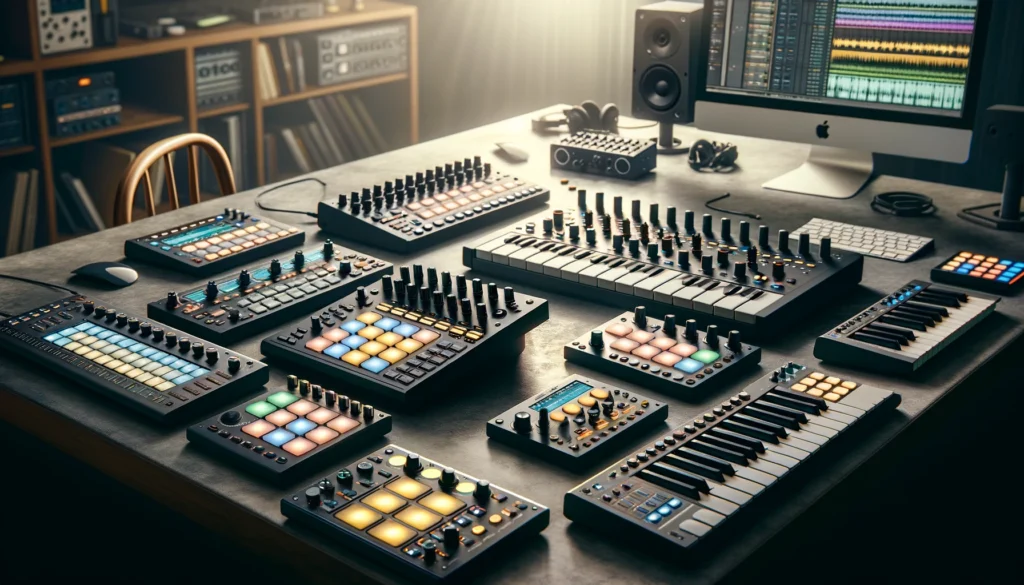
Beyond traditional instruments, there is a whole range of specialty MIDI and production controllers designed to play and interface software tools in creative ways.
Control surfaces like Native Instruments Maschine integrate sequencing pads with software instruments for rhythmic sound triggering.
Assignable hardware like modulation wheels, footpedals, touch plates and fader banks allow infinite options for tactile sound manipulation and mixing.
These bring efficient tactile MIDI software control to producers’ fingertips.
Pad MIDI Controllers
Pad controllers offer great options for triggering MIDI sounds, one-shots, loops and application controls.
Units like Ableton Push 2, Native Instruments Maschine MK3 and Akai’s MAX25 and LPD8 line integrate color displays and 8 to 16 velocity sensitive trigger pads for creative clip launching and sample playback.
Pads can be zoned or setup in different MIDI channels allowing instruments like a melodic bass samples on keys C1 to B1 and lead synth melody samples from C2 to B2 for dynamic triggering of multiple instruments from 2 hands on one unit.
Faders, Knobs and Ribbons
Controlling music applications typically involves adjusting many parameters at once.
Units like Joué by Keith McMillen Instruments or the Novation Launch Control XL make tactile manipulation of volumes, filters, envelopes and effects knobs efficient instead of using only a mouse.
Motorized faders also ensure your DAW mixer levels precisely match the positions of your connected hardware mixers saving time adjusting in tandem.
Conductive silicone touch strips like those on Native Instruments keyboards or the ROLI Seaboard offer continuous pitch bending ribbons for emotive playing gestures bringing MIDI expression to life.
Smartphones and Tablets
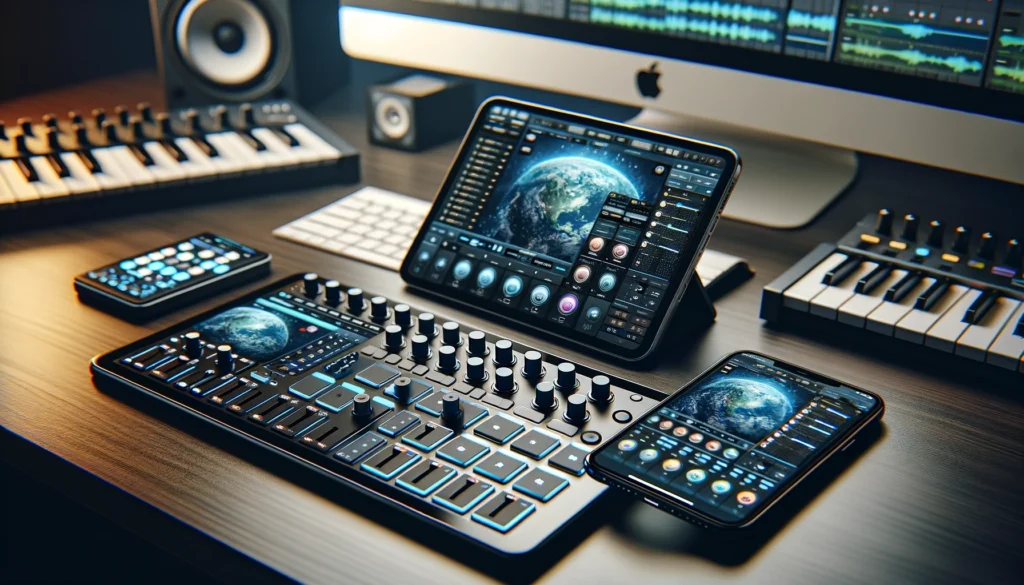
iOS and Android devices have opened up whole new possibilities for using your smartphone as a customizable MIDI controller and wireless musical instrument thanks to Bluetooth and Wi-Fi connectivity.
MIDI controller apps for touch interfaces combined with small mobile MIDI interfaces now enable compact mobile MIDI rigs which fit in your pocket and interface with traditional computers and synth hardware.
Creative coders are also pushing novel ways to manipulate MIDI over multitouch surfaces.
MIDI Controller Apps
Apps like TouchOSC and Lemur turn your phone or tablet screen into a configurable MIDI control panel using onscreen sliders, buttons, ribbons and pads which communicate touch gestures to MIDI devices over Wi-Fi and wired networks.
Physics based iOS apps like Thumbjam offer a different approach to touch MIDI control with plucked string, strumming, drums and configurable synth interfaces played by the various appendages of 2 hands holding a tablet or large smartphone physically.
The app SDKs also allow custom tailoring of MIDI messages from multitouch.
Bluetooth MIDI Interfaces
Small USB and Bluetooth LE adapters like the Yamaha MD-BT01, iConnectivity iConnectMIDI4+ and Latency’s BluetoothMIDI Converters now allow iOS and Android devices to become wireless MIDI controllers for gear with only 5-pin DIN or traditional USB MIDI ports.
Using your phone or tablet as the controller combined with one of these wireless MIDI interfaces offers portable and configurable MIDI manipulation from something as commonplace as your smartphone using the power of mobile apps.
Tablet sized units offer greater real estate for more complex interfaces.
Analogue Tools and Toys
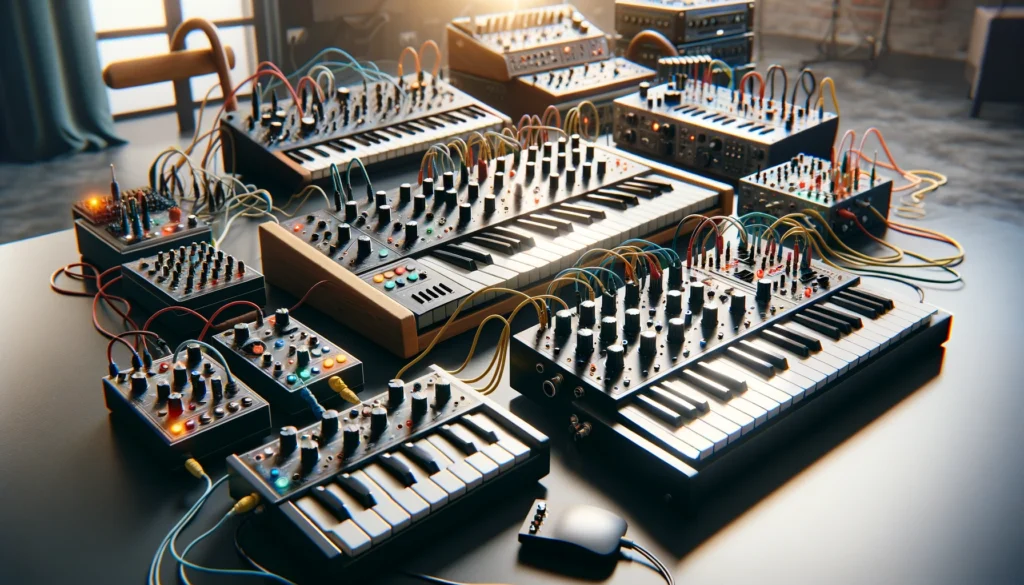
While designed well before the digital MIDI standard, many legacy analogue keyboards, synthesizers and circuit bent toys can still have MIDI control implemented on them through simple MIDI conversion boxes.
This breathes new creative life into classic analogue sounds allowing them to interface as MIDI input devices to sequence MIDI notes, automate parameters or even be re-synthesized as software instruments based on the MIDI data.
Vintage gear and toys can become unique MIDI controllers for music futurists and hipsters.
Retro Keyboards and Synths to MIDI
Using an external MIDI to CV converter, voltage controlled analogue synthesizers like Moog Minimoogs, Arp Odysseys, Korg MS-20s and other coveted vintage and modular analogue synthesizers can usually have their oscillators, LFOs and filter guts controlled externally through MIDI messages.
Devices like the Kenton Pro Solo Mk3 host software configurable MIDI to CV settings turning legacy keyboards into analog-flavoured MIDI controllers to manipulate new digital soundscapes.
The MIDI Accordion by MIDI Solutions even lets you trigger MIDI from squeezebox instruments.
Circuit Bent Toys MIDI Mapped
Circuit bending enthusiasts are finding clever ways to implement MIDI control into hacked and modified children’s toys and low voltage noisemaking devices.
Typical examples include mapping MIDI notes and CCs to the various sound generation points on opened up analogue toy keyboards and sound toys, creating unusual timbres triggered by MIDI events.
Other options include using Arduino based microcontrollers to sense voltages on exposed bent circuits and convert fluctuations into MIDI CC messages for parameter automation.
The possibilities for wacky MIDI controllers are endless for the experimental.
DIY and 3D Printed Controllers
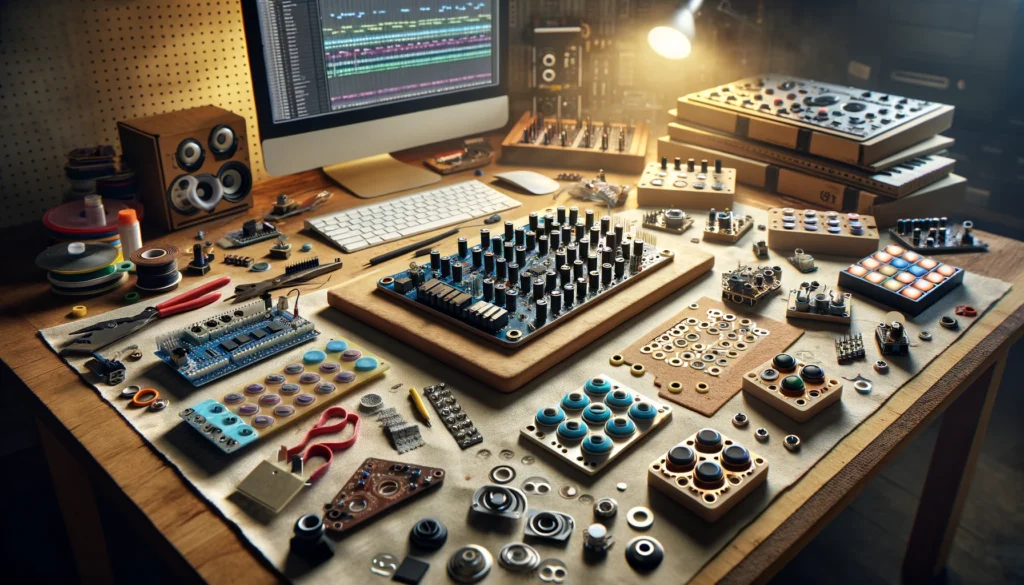
For the hobbyists and tinkerers, all manner of materials from tactile buttons to Arduino boards to conductive fabrics allow custom MIDI controllers to be created from the ground up.
3D printer controller faceplates also now enable one-off MIDI surface designs.
The only limit is one’s imagination when you make your own.
Open source initiatives provide starting points for no
Conclusion
As we’ve discovered, an incredibly diverse array of analog and digital, common and exotic devices can interface as MIDI controllers.
The only limit is one’s imagination when it comes to manipulating MIDI musical creativity through almost any instrument or control surface – even retro and circuit bent toys.
We’ve only scratched the surface of the possibilities.
